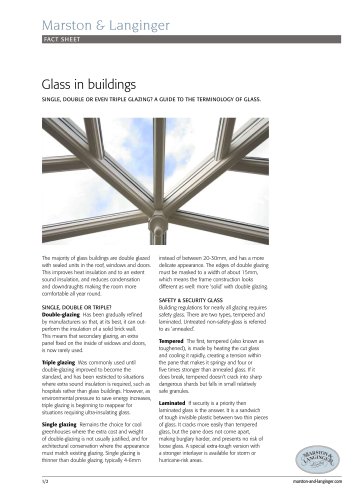
Catalog excerpts

SAFETY & SECURITY GLASS Building regulations for nearly all glazing requires safety glass. There are two types, tempered and laminated. Untreated non-safety-glass is referred to as annealedђ. Tempered The first, tempered (also known as toughened), is made by heating the cut glass and cooling it rapidly, creating a tension within the pane that makes it springy and four or five times stronger than annealed glass. If it does break, tempered doesnt crack into sharp dangerous shards but falls in small relatively safe granules. > Single glazing Remains the choice for cool greenhouses where the extra cost and weight of double-glazing is not usually justified, and for architectural conservation where the appearance must match existing glazing. Single glazing is thinner than double glazing, typically 4-6mm instead of between 20-30mm, and has a more delicate appearance. The edges of double glazing must be masked to a width of about 15mm, which means the frame construction looks different as well: more ґsolid with double glazing. SINGLE, DOUBLE OR TRIPLE? Triple glazing Was commonly used until double-glazing improved to become the standard, and has been restricted to situations where extra sound insulation is required, such as hospitals rather than glass buildings. However, as environmental pressure to save energy increases, triple glazing is beginning to reappear for situations requiring ultra-insulating glass. The majority of glass buildings are double glazed with sealed units in the roof, windows and doors. This improves heat insulation and to an extent sound insulation, and reduces condensation and downdraughts making the room more comfortable all year round. Double-glazing Has been gradually refined by manufacturers so that, at its best, it can out- perform the insulation of a solid brick wall. This means that secondary glazing, an extra panel fixed on the inside of widows and doors, is now rarely used. > 1/2 marston-and-langinger.com size="-1">
Open the catalog to page 1
The gap Double-glazing has an optimum spacing between the panes which Marston & Langingers naturally insulating hardwood frames are designed to accommodate. Gas-filled The cavity between the glass in sealed units benefits by being filled with an inert gas, usually argon, which reduces the transmission of heat. BETTER INSULATION In the past glass buildings devoured vast amounts of heat with steaming pipes and windows. But now, building for the future, that would be probably unaffordable and certainly unacceptable. However huge technical improvements have been made to insulation qualities of...
Open the catalog to page 2Archived catalogs
-
Timber for handmade doors
1 Pages
-
Under floor heating systems
1 Pages
-
How to buy a conservatory
2 Pages





